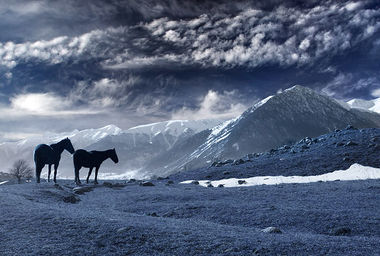Phaswa Mountains
| Darkine | |
|---|---|
 Highlands of Hux Kham, with the Darkine in the background | |
| Highest point | |
| Peak | Mount Dyinsup 46°40'43"N 12°2'29"W |
| Elevation | 6,552 m (21,496 ft) |
| Geography | |
| Countries | |
| Continent | Soltenna |
The Darkine is a mountain range separating West and East Soltenna. It extends from northeastern Qonklaks to central western Liosol, dividing Hux Kham into two geographically separate regions, and bordering the Rapheng and Lion ranges. The Darkine hosts most of Soltenna's highest peaks and all of the region's 6000m peaks outside Bevasejerna, including Soltenna's second highest point in Mount Dyinsup whose height above sea level reached 6,552 metres (21,496 ft). Its English name is derived from the Hux Kham name, Dar Khin, which literally translates to "Smoky Mountains".
Geology
The Darkine's geological history dates back to the (Paleozoic) era when the mountain was formed. It formed largely through collision of the (West Soltennan) and Rietic plates during the Darkine orogeny, which also formed the Rietic Mountains that is believed to have been the part of the Darkine before a rift valley comprising Lake Soltenna was formed around 50 million years ago, splitting the Rietic eastwards. This split increased volcanic activity of both mountain ranges. The Darkine's highest point, Mount Dyinsup, is estimated to move at an annual rate of 1.4 mm (0.055 in) upwards and 3.5 mm (0.14 in) northwards.
Most volcanoes in the region are now dormant, but is still subject to regular strong earthquakes from its tectonic activity. Darkine earthquakes are known to have caused damage indirectly through avalanches.
Climate
Cold continental and semi-arid climates dominate the climate of the Darkine. Average annual temperature in the lakeside Hux Mlak, in comparison, is 14 °C (57 °F), while in Khin Mlak, average annual temperature falls to 6 °C (43 °F). Furthermore to the Mount Dyinsup slopes, average temperatures reached as low as −5 °C (23 °F).
Snow caps of the Darkine feed three major rivers: the Zranx, Methinya, and Glock rivers. Due to the cold climate, the Darkine highlands are overall scarce in vegetation, with most of the area being above the tree line. The Darkine populace are thus reliant on these rivers to live and are scarce in numbers. Although minor, rain shadow effects caused by the Darkine made some areas west of the range—northern Hux Kham and extreme eastern Methinaqh—drier than the eastern counterparts, which comprises the western half of the Lake Soltenna basin.